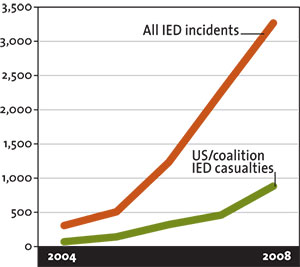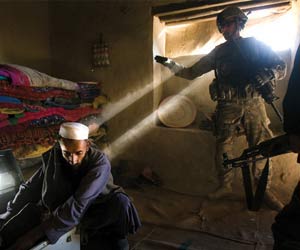OVER THE PAST FEW YEARS, improvised explosive devices, the tactic of choice for Iraqi insurgents, have spread to the Afghan roadside in a big way: At last count, IEDs accounted for more than 70 percent of US combat casualties in Iraq and half of those in Afghanistan. Since 2003, according to Pentagon documents, the Army’s Joint IED Defeat Organization (JIEDDO) and its predecessors have spent $14 billion trying to do what JIEDDO’s name implies, including $2.3 billion for high-tech countermeasures “to thwart simple, cheap triggering devices such as two-way radios or garage door openers.”
In Afghanistan, the pricey gear has helped coalition troops find and clear nearly three times as many bombs in 2008 as in 2006. But the insurgents have kept pace: Casualties from IEDs have increased by nearly the same margin. As for whether the money might not be better spent on, say, humanitarian and development efforts, the IED chasers note that US forces will now likely face this guerrilla tactic wherever they go. “IEDs are a weapon,” notes JIEDDO’s 2008 report to Congress. “They are not the enemy.”
![]() Typical IED Cell
Typical IED Cell
- A financier pays for explosives and cheap electronics
- A bomb builder makes the devices
- An emplacer hides the bombs
- A spotter watches for the approach of military targets
- A triggerman detonates IEDs using devices like cell phones or garage-door openers
- A cameraman tapes the mayhem for online recruitment
![]() How the Military Fights Back
How the Military Fights Back
- Warrior Alpha aerial surveillance spies on suspected bomb makers at a cost of $242 million
- Talon robots and thermal cams suss out IEDs and shady characters
- Rhino predetonation units ($59 million all told) blow up IEDs from afar
- Wolf Collar gear (a $67 million initiative) rakes up IED trigger wires
- Hunter and Chameleon jammers blindly thwart IED electronics
- Dog teams sniff around for hidden bombs
- Husky device (developed for $33.1 million) detects buried explosives
- Truck-mounted “interrogator” arms ($216,500 a pop) probe IEDs
- Frag 5 Humvee-armor kits help protect personnel
IEDS IN AFGHANISTAN

Collateral Damage
Drone air strikes reported since 2007: 40
Civilians they’ve killed: about 200
Wedding parties obliterated by US air raids: at least 2
Total civilians killed in 2008 during Afghan combat: 2,118
Increase over 2007: 39%











